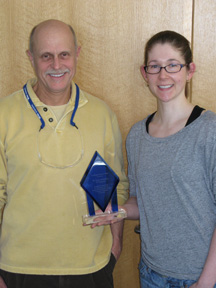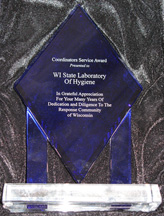 March 24th is World TB Day. The Association of Public Health Laboratories writes about the 2013 TB outbreak in Sheboygan, WI, and the response of the local, state and federal public health system – including the Wisconsin State Laboratory of Hygiene – to show how 1 case of TB can have far-reaching effects in a community and state. APHL Public Health LabLog post
March 24th is World TB Day. The Association of Public Health Laboratories writes about the 2013 TB outbreak in Sheboygan, WI, and the response of the local, state and federal public health system – including the Wisconsin State Laboratory of Hygiene – to show how 1 case of TB can have far-reaching effects in a community and state. APHL Public Health LabLog post
WSLH Honored for Work with Wisconsin’s HazMat Teams

Noel Stanton and Meshel Mork with the WAHMR award.
The Wisconsin Association of Hazardous Materials Responders (WAHMR) gave the WSLH its Coordinators Service Award at its annual conference earlier this month. The award was given “in grateful appreciation for your many years of dedication and diligence to the response community of Wisconsin.”
WSLH Chemical Emergency Response Coordinator Noel Stanton and Assistant Coordinator Meshel Mork accepted the award on behalf of the WSLH.
WSLH staff in the Communicable Disease Division first began working with Wisconsin’s hazardous materials (HazMat) teams in the late 1990s. The focus those first few years was on training for responding to biological terrorism events. Over time the focus switched to an all-hazards approach. Since HazMat teams, which are part of local fire departments, respond to unknown chemical emergencies more often than biological ones, WSLH support has evolved to focus more on unknown chemical incidents.
That support comes in a variety of ways:
- WSLH staff provide testing in our lab for the HazMat teams when needed. This can be for situations where the team has identified a threat or exposure risk, or when the team encounters an unknown substance they can’t identify with their field equipment and they need to know more.
- In order to assure we receive a valid sample for testing, WSLH staff provide collection material kits so HazMat teams have what they need in their mobile response units. The collection materials are suitable for biological as well as chemical agents.
- For HazMat teams with field testing capabilities, the WSLH serves as a resource when they’re in the field responding to an event. WSLH staff also have contacts that can provide a higher level of technical expertise, if needed.
- The WSLH provides a voluntary, no-cost unknown substance characterization program for HazMat teams – basically a proficiency testing program for HazMat. WSLH staff make samples and send them to the teams who characterize the samples based on their unit’s capabilities. After the team sends in their results, WSLH staff provide feedback.
The latest support effort is a ½ day training course for HazMat teams developed by former Chemical Emergency Response Assistant Coordinator (and now WisCon Industrial Hygiene Consultant) Al Spallato. HazMat teams will be instructed on how to properly assess a situation and receive hands-on experience collecting vapor, liquid and solid substances to submit to the WSLH for analysis. The course is being offered in collaboration with Wisconsin Emergency Management and two of the HazMat responder teams. A pilot course was held right before the WAHMR conference and garnered very positive feedback from participants. The first official training session will be held in late February.
“The award was presented to the WSLH for years of service and Al has been instrumental in that,” said Stanton. “With Meshel taking over for Al, the HazMat teams will continue to receive a very high level of support from the WSLH.”

WSLH’s Coordinators Service Award
Welcome to the WSLH’s New Website
Thank you for visiting the Wisconsin State Laboratory of Hygiene’s (WSLH) redesigned website.
A part of the University of Wisconsin-Madison since our founding in 1903, our new web design makes this relationship more apparent through color scheme and logo design.
Key site navigation features:
- Hover your cursor over “WSLH Services” in the navigation bar to see drop-down menus for the clinical, environmental, occupational health, forensic toxicology, and proficiency testing services offered by the WSLH
- Photo links on the home page make it easy to find information on ordering a well water test, search our clinical test listings, and learn more about WSLH employment opportunities, Wisconsin’s Newborn Screening Program, UW Cytogenetics and WSLH Proficiency Testing
- The “Lab Networks & Surveillance” section provides data from our laboratory-based communicable disease surveillance programs, as well as training resources for Wisconsin’s clinical laboratories
Please take a look around and let us know what you think. You can send any comments/suggestions to us via the form at the bottom of the Contacts page.
Thanks!
Water Microbiology Training Sessions
The WSLH Water Microbiology unit will be presenting a series of informational training workshops for Wisconsin Department of Natural Resources and Wisconsin Department of Health Services staff.
All workshop modules will be live-streamed on the web and webcasts will be archived on the WSLH website. You will need Microsoft Silverlight to participate by webcast. You should log into the webcast link for each module (see below) at least a day ahead of time to make sure your computer has the software and, if not, to download it via your department’s software download process.
DNR and DHS staff should RSVP to Rebecca.Munson-Salzwedel@slh.wisc.edu by the dates indicated under each training module.
Module 1 – Basic Water Microbiology, Indicators, Sampling and Testing
Date and Time: Monday, January 27, 2014 – Noon to 1:30 PM
Location: Wisconsin State Laboratory of Hygiene, 2601 Agriculture Drive (Board Room)
Webcast: https://slhstream2.ad.slh.wisc.edu/Mediasite/Play/77c164a1024a4afbbc1460d2298b3f381d
DNR and DHS staff should RSVP to Rebecca.Munson-Salzwedel@slh.wisc.edu by noon January 23, 2014.
Module 2 – Higher Level Microbial Testing and Fecal Source Tracking
Date and Time: Monday March 24, 2014 – Noon to 1:30 PM (rescheduled from Feb. 21 due to weather)
Location: Wisconsin State Laboratory of Hygiene, 2601 Agriculture Drive (Fishbowl Room)
Webcast: https://slhstream2.ad.slh.wisc.edu/Mediasite/Play/1d1d2498bbbd4141a31326ef55f086191d
DNR and DHS staff should RSVP to Rebecca.Munson-Salzwedel@slh.wisc.edu by noon March 20, 2014.
Module 3 – Wastewater and Biosolids
Date and Time: Thursday March 20, 2014 – Noon to 1:00 PM
Location: Wisconsin State Laboratory of Hygiene, 2601 Agriculture Drive (Fishbowl Room)
Webcast: https://slhstream2.ad.slh.wisc.edu/Mediasite/Play/d54e8c709ae04366b21c4675294ddfe61d
DNR and DHS staff should RSVP to Rebecca.Munson-Salzwedel@slh.wisc.edu by noon March 17, 2014.
Molecular Genetics Fellowship Accreditation
The following was published in the University of Wisconsin School of Medicine and Public Health’s UWSMPH Update
 The University of Wisconsin (UW) Department of Pediatrics, in partnership with the UW Department of Pathology and Laboratory Medicine, has received accreditation by the American Board of Medical Genetics (ABMG) for an inter-institutional post-doctoral fellowship in Clinical Molecular Genetics.
The University of Wisconsin (UW) Department of Pediatrics, in partnership with the UW Department of Pathology and Laboratory Medicine, has received accreditation by the American Board of Medical Genetics (ABMG) for an inter-institutional post-doctoral fellowship in Clinical Molecular Genetics.
Under the technical direction of Jennifer Laffin, PhD, FACMG, director, UW Cytogenetic Services Laboratory, Wisconsin State Laboratory of Hygiene, and assistant professor, SMPH Department of Pediatrics, the program highlights collaboration between the UW; PreventionGenetics, Inc., in Marshfield; and the Blood Center of Wisconsin in Milwaukee. It offers a comprehensive, post-doctoral training program in a wide range of molecular diagnostic techniques.
This fellowship program joins the UW’s ABMG fellowship programs in Clinical Genetics, Biochemical Genetics and Cytogenetics, under the direction of David Wargowski, MD, professor, Department of Pediatrics-Genetics and Metabolism. The new program is one of 38 clinical molecular genetics programs in the U.S. and makes the UW-Madison one of 27 institutions offering a full menu of clinical laboratory genetics specializations.
Research Finds Drugs in Lake Michigan, Miles from Shore
Feb. 26, 2014 UW Wednesday Nite @ the Lab talk about the research – Video
With their large size and water volume, it’s long been assumed by researchers that the Great Lakes would dilute compounds that flow into them from sewage outfalls.
But research recently published in the journal Chemosphere by the University of Wisconsin-Milwaukee School of Freshwater Sciences and the Wisconsin State Laboratory of Hygiene (WSLH) shows that pharmaceuticals and personal care products (PPCPs) are contaminating Lake Michigan two miles offshore from Milwaukee, indicating a potential threat to the health of the Great Lakes, particularly near shore aquatic organisms.
The research also was written about in Environmental Health News.
The overall research project was led by Dr. Rebecca Klaper, an associate professor at the UW-Milwaukee School of Freshwater Sciences. At the WSLH, Research Scientist Dr. Curtis Hedman, Advanced Microbiologist Archie (Alan) Degnan and three UW-Madison students – Steven Quinlan, Nicole Nicksic and Yajaira Pluess – performed testing and provided analysis of the water samples.
Below is a quick Q&A with Dr. Hedman about the study and the WSLH’s role in PPCP research.
What surprised you or didn’t surprise you about the study results?
The biggest surprise in the study results was the presence of PPCPs in concentrations that are estimated to cause environmental concern for aquatic organisms 3.2 km into Lake Michigan. The previous consensus was that large lake dilution effects would render these compounds innocuous.
A question people often ask about this type of research is “So what? You found stuff in the water. How does that affect me?” Is there a way to answer that question with this research or are further studies needed?
Protecting aquatic organisms is important in that even a subtle change in the behavior or survival of one aquatic population can cause large scale problems or even collapse of an ecosystem. These aquatic organisms are also considered ‘sentinels’ for eventual human health effects if contaminant levels continue to occur and potentially rise, unchecked.
The WSLH has been involved in PPCP research before. Was this project similar to others or different?
The WSLH has performed PPCP and hormone analysis for other research projects in the past, but the analysis was focused upon groundwater and small streams and lakes. This was the first time that this type of monitoring was performed on Lake Michigan by the WSLH.
How did the WSLH become involved in the project? Are there plans for further research about PPCPs in Lake Michigan and will the WSLH be involved?
Dr. Rebecca Klaper became aware of the WSLH Environmental Health Division’s testing capabilities for PPCPs and hormones through previous WSLH collaborations with her colleagues at UW-Milwaukee’s Center for Great Lakes Studies. Researchers from Dr. Klaper’s lab continue to collaborate with the WSLH on projects related to this work. We are currently testing different wastewater treatment techniques to improve sequestration and breakdown of these compounds prior to their release to the environment. Our hope is that the Lake Michigan findings published in Chemosphere may raise awareness and result in additional funding to continue Great Lakes monitoring for these compounds.
Specifically, what type of analytical testing work did the WSLH perform?
The WSLH performed the analysis of these samples by methods based upon US EPA Method 1694 (Pharmaceuticals and Personal Care Products in Water, Soil, Sediment, and Biosolids) and US EPA Method 1698 (Steroids and Hormones in Water, Soil, Sediment, and Biosolids). Dr. Klaper’s research group performed the sample collections on Lake Michigan using the research vessel Neeskay. Sample preparation procedures were performed both at WSLH and at the UW-Milwaukee Center for Great Lakes Studies (also known as the Wisconsin Aquatic Technology and Environmental Research (WATER) Institute).
Newborn Screening: 50 Years of Saving Lives
 2013 marks the 50th anniversary of newborn screening nationally.
2013 marks the 50th anniversary of newborn screening nationally.
Wisconsin’s newborn screening program and history are featured in the University of Wisconsin School of Medicine and Public Health’s Quarterly magazine.
Metals Toxicity and the Great Lakes Shoreline
Research conducted by Dr. Martin Shafer and Wisconsin State Laboratory of Hygiene (WSLH) scientists “… have discovered key factors in predicting how and at what levels (copper and cadmium) harm the shoreline environment of the Great Lakes and what protective measures coastal organisms adopt in response. That’s allowed regulatory agencies … to refine tools to protect Great Lakes coastal regions from the metals.”
Most of the analyses for this research project were performed at the WSLH. The metals were analyzed in the Trace Elements Clean Laboratory and the Reactive Oxygen Species (ROS) assays were performed in the Environmental Toxicology Laboratory.
Read all about the project in the University of Wisconsin Aquatic Sciences Center’s Chronicle.
The National Oceanic and Atmospheric Administration (NOAA) also posted the story (4/4/14).
Why Does Toxic Chromium VI Form in Wisconsin Groundwater? WSLH and Wisconsin Researchers Look for an Answer
Wisconsin State Laboratory of Hygiene (WSLH) Inorganic Chemistry and Trace Elements Clean Laboratory Director Dr. Patrick Gorski is leading a multi-agency team looking at the factors that determine the natural concentration of hexavalent chromium – aka Chromium VI – in Wisconsin groundwater.
The research project – using funding administered through the University of Wisconsin Water Resources Institute – was spurred when Chromium VI was found in drinking water wells in Madison, WI. The levels were low so it probably wasn’t due to industrial contamination, which started Gorski thinking about how and why it got there.
Researchers are in the second year of the two-year project and are investigating how geology and environment may play a role.
Read more about the project.